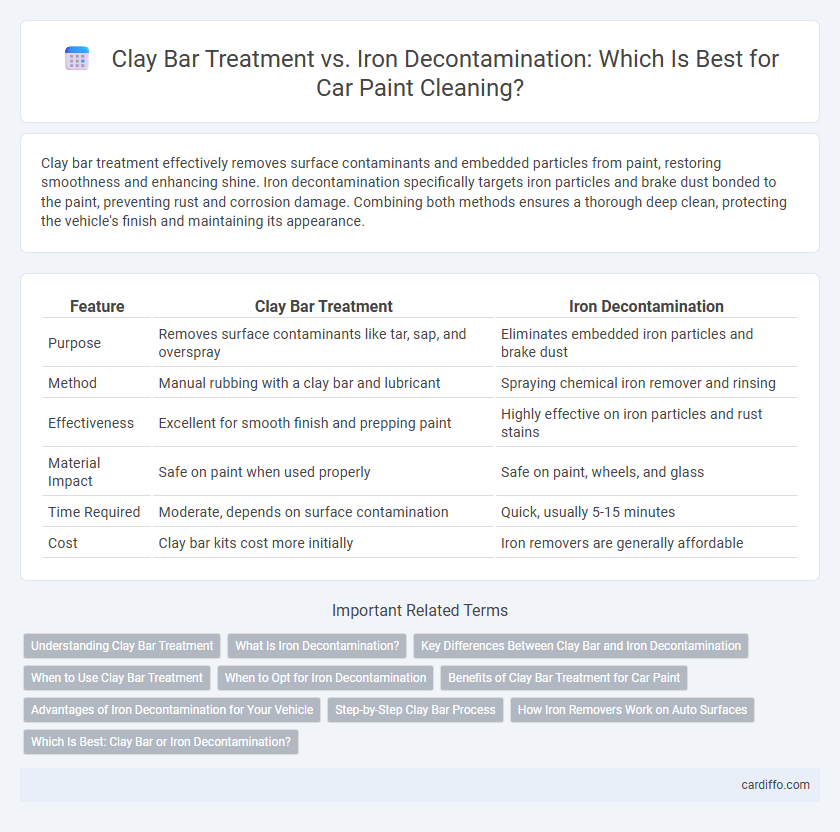Clay bar treatment effectively removes surface contaminants and embedded particles from paint, restoring smoothness and enhancing shine. Iron decontamination specifically targets iron particles and brake dust bonded to the paint, preventing rust and corrosion damage. Combining both methods ensures a thorough deep clean, protecting the vehicle's finish and maintaining its appearance.
Table of Comparison
| Feature | Clay Bar Treatment | Iron Decontamination |
|---|---|---|
| Purpose | Removes surface contaminants like tar, sap, and overspray | Eliminates embedded iron particles and brake dust |
| Method | Manual rubbing with a clay bar and lubricant | Spraying chemical iron remover and rinsing |
| Effectiveness | Excellent for smooth finish and prepping paint | Highly effective on iron particles and rust stains |
| Material Impact | Safe on paint when used properly | Safe on paint, wheels, and glass |
| Time Required | Moderate, depends on surface contamination | Quick, usually 5-15 minutes |
| Cost | Clay bar kits cost more initially | Iron removers are generally affordable |
Understanding Clay Bar Treatment
Clay bar treatment is a specialized car detailing process that removes bonded surface contaminants such as industrial fallout, tree sap, and overspray that regular washing cannot eliminate. This polymer clay material gently lifts embedded particles without damaging the paint, thereby restoring smoothness and improving the vehicle's finish. Unlike iron decontamination, which targets ferrous particles using chemical solutions to dissolve rust-based contaminants, clay bar treatment physically extracts a broader range of pollutants to prepare the surface for polishing and waxing.
What Is Iron Decontamination?
Iron decontamination is a specialized automotive cleaning process that removes embedded iron particles from paint surfaces, which traditional washing cannot eliminate. It utilizes chemical agents that react with iron deposits, turning them purple before safely dissolving or loosening the contaminants. This treatment prevents paint damage, corrosion, and ensures a smoother, cleaner finish compared to clay bar treatment, which physically removes surface contaminants but is less effective on iron particles.
Key Differences Between Clay Bar and Iron Decontamination
Clay bar treatment physically removes bonded contaminants such as tar, sap, and overspray from the paint surface using a lubricated clay compound, restoring smoothness and enhancing paint clarity. Iron decontamination specifically targets and dissolves iron particles and brake dust embedded in the paint, typically using a chemical iron fallout remover that changes color upon reaction. Unlike clay bar treatment which requires manual rubbing, iron decontamination relies on chemical action to eliminate invisible contamination without abrasion.
When to Use Clay Bar Treatment
Clay bar treatment is ideal when removing surface contaminants like paint overspray, tree sap, and road grime that regular washing cannot eliminate. It effectively smooths the paint surface before polishing or waxing, enhancing the vehicle's finish and shine. Use clay bar treatment when the surface feels rough or has embedded particles visible after washing.
When to Opt for Iron Decontamination
Iron decontamination is essential when vehicles exhibit visible rust spots or magnetic metallic particles embedded in the paint, which clay bar treatment alone cannot effectively remove. This process uses chemical agents to dissolve iron oxide contaminants, preventing further corrosion and paint damage. Opt for iron decontamination before applying a clay bar treatment to ensure optimal surface cleanliness and protection.
Benefits of Clay Bar Treatment for Car Paint
Clay bar treatment effectively removes surface contaminants like industrial fallout, tree sap, and brake dust that traditional washing cannot eliminate, resulting in a smoother car paint finish. This process enhances paint clarity and gloss by creating an ultra-clean surface that prepares the paint for waxing or sealing. Regular use of clay bar treatment prevents paint deterioration and maintains the vehicle's aesthetic appeal over time.
Advantages of Iron Decontamination for Your Vehicle
Iron decontamination effectively removes embedded iron particles from the vehicle's paint, preventing rust and corrosion that clay bar treatments cannot address. This process enhances paint longevity and prepares the surface for better bonding with protective coatings. Iron decontamination is less abrasive than clay bar treatment, preserving the clear coat and reducing the risk of micro-scratches.
Step-by-Step Clay Bar Process
The clay bar treatment involves a step-by-step process starting with thorough washing and drying of the vehicle to remove surface dirt. Next, a lubricating spray is applied to a small section where the clay bar is gently rubbed over the paint to lift embedded contaminants like rail dust and industrial fallout. This method enhances smoothness and paint clarity by physically removing bonded impurities that iron decontamination alone cannot eliminate.
How Iron Removers Work on Auto Surfaces
Iron removers work by chemically reacting with iron particles embedded in auto surfaces, breaking them down into a soluble form that can be easily rinsed away. These products contain active ingredients such as chelating agents or acids that dissolve iron oxide contaminants without damaging the paint. Unlike clay bar treatments, which physically lift contaminants, iron removers provide a targeted, non-abrasive method to eliminate rust deposits and brake dust from vehicle paintwork.
Which Is Best: Clay Bar or Iron Decontamination?
Clay bar treatment removes surface contaminants like overspray and tar, restoring smoothness and shine by physically lifting particles from the paint. Iron decontamination targets embedded iron particles from brake dust and industrial fallout, chemically dissolving residue that a clay bar cannot remove. For comprehensive paint correction, combining iron decontamination for embedded particles with clay bar treatment for overall surface smoothness provides the best results in automotive detailing.
Clay Bar Treatment vs Iron Decontamination Infographic

 cardiffo.com
cardiffo.com